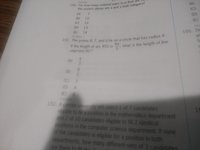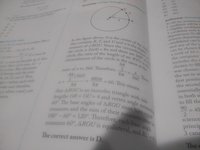Why did they get 4. My first calculation makes sense. If you look at the picture of a circle they drew or you can make one, then what you are looking for is the length of the whole circle minus the arc RTU as RU is everything else.
The second method I used and they did too--- says that 8pie is the same as 360 degrees as both equal the whole for a circle( one is whole length and the other is total degrees in a circle), but I don't get why I got the answer wrong since I did 180 - 60 = 120 just like them. I don't really understand why I have to subtract 60 from 180, but they did it, so I did it. They then talked about equilateral triangles(I don't know why they are throwing that in???).
If you can translate their writing for me that would be cool too, but for the GMAT I have 2 minutes per question and I want to prepare for it.
The second method I used is not really from my thinking, but is the result of the Youtube video and looking at the book's explanation --- if anyone wants to clarify it, feel free.
You have completely misunderstood the question.
Yes, it is certainly true that if the length of the arc RTU is [MATH]4 \pi / 3[/MATH], there is another arc UR, which has length [MATH]8 \pi - ( 4 \pi / 3) = 20 \pi / 3[/MATH] because the radius is 4 so the circumference is [MATH]8 \pi.[/MATH]
But you are not asked about that other arc at all. You are asked about the length of the straight line joining R and U.
Now one of the geometric facts that is relevant to this problem and that you are supposed to know and recognize is that, if you are measuring angles in degrees, the ratio of the length of an arc of a circle relative to the circumference of that circle equals the ratio of the angle subtending that arc relative to 360 degrees. Another relevant geometric fact that you are supposed to recognize is that the line subtending any arc except a semi-circle forms the base of an isosceles triangle with the equal sides running from the center of the circle to the end points of the arc. If you don't get this intuitively, sketch the circle with center O, radius 4, line RU subtending arc RTU, and draw the lines OR and OU. So you have triangle ORU. The final relevant geometric fact that you are expected to know is that the base angles of an isoceles triangle are equal. Now you put all this together.
[MATH]a = \text {measure in degrees of } \angle \text { ROU.}[/MATH]
[MATH]b = \text {measure in degrees of each base angle.}[/MATH]
Two unknowns require two independent equations.
[MATH]\dfrac{a}{360} = \dfrac{\dfrac{4 \pi}{3}}{8 \pi} = \dfrac{4 \pi}{3} * \dfrac{ 1}{8 \pi} = \dfrac{1}{6}.[/MATH]
[MATH]a + b + b = 180 \implies b = \dfrac{180 - a}{2}.[/MATH]
[MATH]\text {But } \dfrac{a}{360} = \dfrac{1}{6} \implies a = \dfrac{360}{6} = 60 \implies b = 60.[/MATH]
So all the angles in the triangle are equal to 60 degrees. So it is what kind of triangle? How does that let you answer the question?
The actual computations in this problem are quite easy. It can be done well within 2 minutes if first you read the problem
carefully, second make a crude sketch, and lastly have the relevant geometric facts at your fingertips. This problem tests your knowledge of geometric facts, not computational skill.


